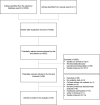Effects of Stool Sample Preservation Methods on Gut Microbiota Biodiversity: New Original Data and Systematic Review with Meta-Analysis
- PMID: 37093040
- PMCID: PMC10269478
- DOI: 10.1128/spectrum.04297-22
Effects of Stool Sample Preservation Methods on Gut Microbiota Biodiversity: New Original Data and Systematic Review with Meta-Analysis
Abstract
Here, we aimed to compare the effects of different preservation methods on outcomes of fecal microbiota. We evaluated the effects of different preservation methods using stool sample preservation experiments for up to 1 year. The stool samples from feces of healthy volunteers were grouped based on whether absolute ethanol was added and whether they were hypothermically preserved. Besides, we performed a systematic review to combine current fecal microbiota preservation evidence. We found that Proteobacteria changed significantly and Veillonellaceae decreased significantly in the 12th month in the room temperature + absolute ethanol group. The four cryopreservation groups have more similarities with fresh sample in the 12 months; however, different cryopreservation methods have different effects on several phyla, families, and genera. A systematic review showed that the Shannon diversity and Simpson index of samples stored in RNAlater for 1 month were not statistically significant compared with those stored immediately at -80°C (P = 0.220 and P = 0.123, respectively). The -80°C refrigerator and liquid nitrogen cryopreservation with 10% glycerine can both maintain stable microbiota of stool samples for long-term preservation. The addition of absolute ethanol to cryopreserved samples had no significant difference in the effect of preserving fecal microbial characteristics. Our study provides empirical insights into preservation details for future studies of the long-term preservation of fecal microbiota. Systematic review and meta-analysis found that the gut microbiota structure, composition, and diversity of samples preserved by storage methods, such as preservation solution, are relatively stable, which were suitable for short-term storage at room temperature. IMPORTANCE The study of gut bacteria has become increasingly popular, and fecal sample preservation methods and times need to be standardized. Here, we detail a 12-month study of fecal sample preservation, and our study provides an empirical reference about experimental details for long-term high-quality storage of fecal samples in the field of gut microbiology research. The results showed that the combination of -80°C/liquid nitrogen deep cryopreservation and 10% glycerol was the most effective method for the preservation of stool samples, which is suitable for long-term storage for at least 12 months. The addition of anhydrous ethanol to the deep cryopreserved samples did not make a significant difference in the preservation of fecal microbiological characteristics. Combined with the results of systematic reviews and meta-analyses, we believe that, when researchers preserve fecal specimens, it is essential to select the proper preservation method and time period in accordance with the goal of the study.
Keywords: biological sample; gut microbiome; preservation; stool.
Conflict of interest statement
The authors declare no conflict of interest.
Figures






Similar articles
-
Effects of different preservation methods on biomacromolecules and microbial flora.Zhong Nan Da Xue Xue Bao Yi Xue Ban. 2020 Aug 28;45(8):909-915. doi: 10.11817/j.issn.1672-7347.2020.190083. Zhong Nan Da Xue Xue Bao Yi Xue Ban. 2020. PMID: 33053531 Chinese, English.
-
Effect of preservation method on spider monkey (Ateles geoffroyi) fecal microbiota over 8 weeks.J Microbiol Methods. 2015 Jun;113:16-26. doi: 10.1016/j.mimet.2015.03.021. Epub 2015 Mar 27. J Microbiol Methods. 2015. PMID: 25819008
-
Effects of the long-term storage of human fecal microbiota samples collected in RNAlater.Sci Rep. 2019 Jan 24;9(1):601. doi: 10.1038/s41598-018-36953-5. Sci Rep. 2019. PMID: 30679604 Free PMC article.
-
Emerging importance of stool preservation methods in OMICS studies with special focus on cancer biology.Cell Biochem Funct. 2024 Jul;42(5):e4063. doi: 10.1002/cbf.4063. Cell Biochem Funct. 2024. PMID: 38961596 Review.
-
Rejuvenating the human gut microbiome.Trends Mol Med. 2022 Aug;28(8):619-630. doi: 10.1016/j.molmed.2022.05.005. Epub 2022 Jun 30. Trends Mol Med. 2022. PMID: 35781423 Free PMC article. Review.
Cited by
-
FBS-based cryoprotective compositions for effective cryopreservation of gut microbiota and key intestinal microorganisms.BMC Res Notes. 2024 Jun 19;17(1):168. doi: 10.1186/s13104-024-06836-2. BMC Res Notes. 2024. PMID: 38898515 Free PMC article.
-
DNA extraction protocols for animal fecal material on blood spot cards.PLoS One. 2025 May 12;20(5):e0313808. doi: 10.1371/journal.pone.0313808. eCollection 2025. PLoS One. 2025. PMID: 40354439 Free PMC article.
-
Comparative analysis of adhesion virulence protein FadA from gut-associated bacteria of colorectal cancer patients (F. nucleatum) and healthy individuals (E. cloacae).J Cancer. 2024 Aug 19;15(17):5492-5505. doi: 10.7150/jca.98951. eCollection 2024. J Cancer. 2024. PMID: 39308684 Free PMC article.
-
Current Trends and Challenges of Microbiome Research in Prostate Cancer.Curr Oncol Rep. 2024 May;26(5):477-487. doi: 10.1007/s11912-024-01520-x. Epub 2024 Apr 4. Curr Oncol Rep. 2024. PMID: 38573440 Review.
-
Effects of storage conditions on the microbiota of fecal samples collected from dairy cattle.PLoS One. 2024 Aug 9;19(8):e0308571. doi: 10.1371/journal.pone.0308571. eCollection 2024. PLoS One. 2024. PMID: 39121104 Free PMC article.
References
-
- Li J, Jia H, Cai X, Zhong H, Feng Q, Sunagawa S, Arumugam M, Kultima JR, Prifti E, Nielsen T, Juncker AS, Manichanh C, Chen B, Zhang W, Levenez F, Wang J, Xu X, Xiao L, Liang S, Zhang D, Zhang Z, Chen W, Zhao H, Al-Aama JY, Edris S, Yang H, Wang J, Hansen T, Nielsen HB, Brunak S, Kristiansen K, Guarner F, Pedersen O, Doré J, Ehrlich SD, Bork P, Wang J, MetaHIT Consortium . 2014. An integrated catalog of reference genes in the human gut microbiome. Nat Biotechnol 32:834–841. doi: 10.1038/nbt.2942. - DOI - PubMed
Publication types
MeSH terms
Substances
LinkOut - more resources
Full Text Sources
Miscellaneous

